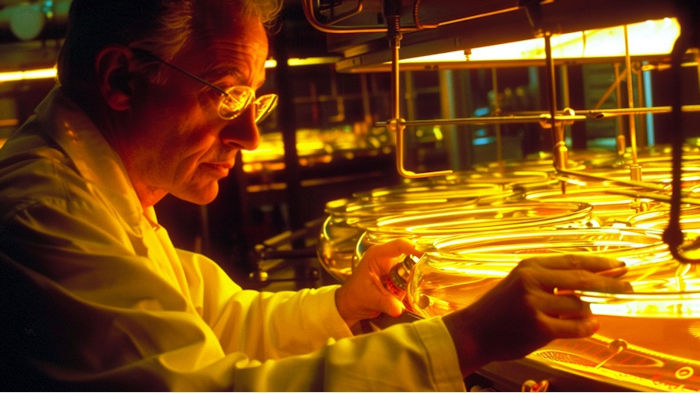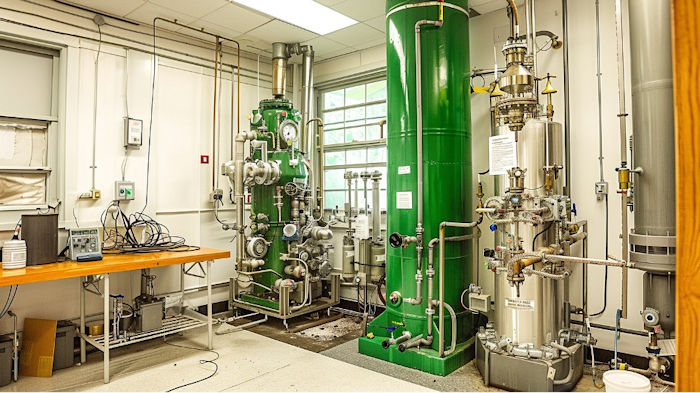In the ever-evolving landscape of material science, a groundbreaking discovery has emerged that may redefine the boundaries of what’s possible with elemental materials. Dubbed “goldene,” this new material is the world’s thinnest gold leaf, measuring a mere single atom in thickness. This remarkable achievement was published in the prestigious journal Nature Synthesis on April 16, 2024, marking a significant milestone in the field of nanotechnology.
Goldene is not just notable for its minuscule thickness; it represents the latest advancement in the category of two-dimensional (2D) materials. These materials are renowned for their extraordinary properties, which differ significantly from their bulk counterparts. Since the discovery of graphene in 2004, scientists have been keenly interested in 2D materials for their unique optical, electronic, and catalytic behaviors. Goldene, with its single-atom structure, is poised to push these boundaries even further.
The potential applications of goldene are vast and varied, hinting at a new era of technological innovation. One of the most promising uses of goldene lies in environmental technology, particularly in processes designed to mitigate climate change. Due to its enhanced chemical reactivity, goldene could play a crucial role in converting carbon dioxide into useful fuels, such as ethanol or methane. This process, known as carbon capture and utilization, seeks to not only reduce the levels of harmful CO2 in the atmosphere but also to transform it into commercially viable products.
Additionally, goldene could revolutionize the field of energy by facilitating the efficient generation of hydrogen through water splitting. Hydrogen is often touted as the clean fuel of the future, and improving the efficiency of its production is critical for realizing its potential as a sustainable energy resource. Goldene’s unique properties could significantly enhance the catalytic processes required for hydrogen production, making it a key player in the transition to green energy solutions.
Beyond these applications, goldene’s atomic-scale precision and stability open the doors to various other fields, including electronics, where it could contribute to the development of ultra-thin, high-performance devices. Its arrival promises not only advancements in existing technologies but also the potential for entirely new applications yet to be imagined.
As we stand on the brink of these exciting possibilities, goldene exemplifies the synergy between historical craftsmanship and cutting-edge science—a synergy that continues to drive innovation and expand the horizons of human knowledge and capability.

The allure of 2D materials lies in their exceptional characteristics – unique optical, electronic, and catalytic properties.
Background on 2D Materials
Introduction to 2D Materials
The story of two-dimensional (2D) materials began in earnest with the isolation of graphene at the University of Manchester in 2004. Graphene—a single layer of carbon atoms arranged in a hexagonal lattice—ushered in a new era in material science due to its remarkable properties. This discovery earned the researchers involved, Andre Geim and Konstantin Novoselov, the Nobel Prize in Physics in 2010, highlighting the significant impact of 2D materials on science and technology.
Significance of 2D Materials
The allure of 2D materials lies in their exceptional characteristics, which are not found in their bulk forms. These materials exhibit unique optical, electronic, and catalytic properties that make them highly desirable for various applications:
- Optical Properties: Many 2D materials can interact with light in unique ways, which is crucial for applications in sensors and photovoltaics.
- Electronic Properties: The electron mobility in materials like graphene is extraordinarily high, making them excellent candidates for next-generation electronic and computing devices.
- Catalytic Properties: The surface area-to-volume ratio of 2D materials is extremely high, which enhances their effectiveness as catalysts in chemical reactions, such as hydrogen production or carbon dioxide reduction.
Challenges in Synthesis
While the fabrication of 2D materials like graphene, molybdenum disulfide, and boron nitride has become more refined, producing single-atom sheets of pure metals presents unique challenges:
- Bonding Tendencies: Metals have a natural tendency to bond with each other due to their delocalized electron cloud. This characteristic makes it difficult to maintain them in a stable, isolated, single-atom form.
- Structural Stability: Unlike nonmetals, which can readily form stable 2D networks, metals require specific conditions to form stable monolayers without aggregating or forming larger particles.
- Complex Fabrication Techniques: The synthesis of metal monolayers often necessitates sophisticated and delicate fabrication techniques that can isolate individual atoms while preventing them from clustering.
Creating goldene represents a breakthrough in this area, employing advanced techniques that build on historical methods to create a stable sheet of gold just one atom thick. This achievement not only expands the family of 2D materials but also opens up new possibilities for utilizing elemental metals in ways that were previously thought to be impractical or impossible.

The creation of goldene uses a synthesis method inspired by a century-old technique once employed by Japanese iron smiths.
Discovery and Creation of Goldene
Innovative Synthesis Method
The creation of goldene represents a significant technological leap. It utilizes a synthesis method inspired by a century-old technique once employed by Japanese iron smiths. This ancient approach involved precise control over the material at the atomic level, a concept that researchers have now adapted to work with gold. The innovative method utilized in the creation of goldene marries traditional metallurgical skills with advanced nanotechnology, demonstrating how historical techniques can find new life in modern scientific research.
Detailed Synthesis Process
Published in Nature Synthesis, the process of creating goldene involves a sophisticated layering and substitution technique:
- Layering: The initial step involves creating a layered structure composed of titanium, silicon, and carbon. This composite serves as the foundation upon which gold atoms are deposited.
- Atomic Replacement: In the critical phase of the process, the silicon layer is targeted for replacement. Gold atoms are introduced onto the surface, and under controlled conditions, they diffuse into the structure, specifically replacing the silicon atoms. This precise diffusion is crucial for the formation of a uniform single-atom layer.
- Solid Support Maintenance: Unlike previous methods, the gold atoms are embedded within the remaining layers of titanium and carbon, providing stability and preventing the gold from clustering.
Overcoming Previous Challenges
Historically, the challenge in creating monolayers of gold has revolved around the metal’s propensity to agglomerate or cluster when isolated at the atomic scale. Previous attempts often resulted in the formation of gold nanoparticles rather than a continuous monolayer due to the inherent bonding tendencies of gold atoms:
- Support Structures: In earlier experiments, researchers attempted to stabilize gold atoms using various support structures, such as graphene-coated silicon carbide. However, once the support was removed, the gold atoms would typically coalesce into nanoparticles, losing the desired monolayer structure.
- Innovative Solution: The method described in Nature Synthesis cleverly circumvents this problem by keeping the gold atoms embedded within a stable matrix of other materials throughout the process. Only after the gold layer has formed do researchers carefully etch away the surrounding materials. This technique ensures that the gold atoms form a stable, freestanding monolayer, as they are never left unsupported during the critical phases of the synthesis.
This innovative approach not only solves a longstanding problem in the synthesis of metallic monolayers but also opens the door to new possibilities for using these materials in various high-tech applications. By successfully isolating gold in a two-dimensional form, researchers have paved the way for future advancements in the field of material science.

One of the critical steps in the production of goldene is the chemical etching process.
Technical Insights into Goldene Production
Chemical Etching Process
One of the critical steps in the production of goldene is the chemical etching process, which involves the use of Murakami’s reagent, an alkaline solution of potassium ferricyanide. This reagent has a storied history, originally used by Japanese craftsmen for fine-tuning the properties of steel. In the context of goldene production, it plays a pivotal role in the selective removal of the non-gold layers from the initial composite structure. Here’s how it works:
- Selective Etching: The Murakami’s reagent specifically targets the titanium carbide layer in the composite, dissolving it without affecting the gold layer. This selective etching is crucial as it preserves the integrity of the monolayer gold while removing other materials.
- Controlled Reaction Conditions: The process requires precise control over factors such as temperature, concentration of the reagent, and etching time to ensure that only the desired material is removed and the gold atoms remain perfectly arranged in a single layer.
Role of Cysteine as a Surfactant
Cysteine, an amino acid, is added to the process as a surfactant. Surfactants decrease the surface tension of a liquid, a property exploited in this context to stabilize the gold sheets at the molecular level. Here’s the impact of adding cysteine:
- Stabilization: Cysteine molecules bind to the gold atoms, preventing them from clustering into larger particles. This binding helps maintain the structural integrity of the goldene sheets.
- Enhancing Dispersion: By decreasing the surface tension, cysteine helps in uniformly spreading the gold atoms across the substrate, promoting the formation of a continuous, uniform monolayer.
Physical Properties of Goldene
The resulting goldene sheets exhibit remarkable physical properties that set them apart from traditional gold leaf and other materials:
- Thickness: Goldene sheets are composed of a single layer of gold atoms, making them significantly thinner than the traditional gold leaf, which is typically several hundred nanometers thick. The atomistic thickness of goldene translates to unprecedented levels of thinness, measured in the angstrom range.
- strong>Length and Stability: Despite their thinness, goldene sheets can be up to 100 nanometers long. This relatively large size at such a thin scale is critical for practical applications, as it ensures enough surface area for catalytic and electronic functions while maintaining stability and handling ease.
- Optical Properties: The ultra-thin nature of goldene allows for unique optical properties, including high transparency and distinctive interactions with light, which could be harnessed in advanced optical devices and sensors.
Through these advanced technical processes and the unique physical characteristics they produce, goldene stands out not only as a scientific curiosity but as a potentially transformative material for numerous applications in technology and industry.

Goldene will revolutionize the way we convert carbon dioxide into usable fuels like ethanol and methane.
Applications and Future Potential of Goldene
Environmental Technology and Energy Production
Goldene, with its unprecedented properties, holds promising potential for application in critical sectors such as environmental technology and energy production:
- Environmental Remediation: In environmental technology, goldene’s enhanced surface area and reactivity could make it an ideal candidate for absorbing pollutants or breaking down hazardous compounds more efficiently than current materials.
- Energy Efficiency: For energy production, the unique properties of goldene might lead to more efficient solar cells or energy storage systems, improving performance and lowering the costs of renewable energy technologies.
Revolutionizing Chemical Reactions
One of the most exciting potential applications of goldene lies in its ability to catalyze reactions that are crucial for sustainable energy solutions and environmental management:
- Carbon Dioxide Conversion: Goldene’s enhanced chemical reactivity could revolutionize the way we convert carbon dioxide into usable fuels like ethanol and methane. By facilitating these reactions more efficiently, goldene could help in tackling the increasing levels of CO2 in the atmosphere, a major contributor to global warming.
- Hydrogen Production: Similarly, the splitting of water to produce hydrogen, which is seen as a clean alternative to fossil fuels, could be greatly enhanced by the catalytic properties of goldene. More efficient hydrogen production would bolster the viability of hydrogen as a widespread energy source, supporting the global shift towards sustainable energy.
Ongoing Research and Development
Research into goldene is still in its early stages, with several key areas being the focus of ongoing studies:
- Improving Yield and Size: Researchers are working to improve both the yield and the dimensions of goldene sheets produced. Larger and more consistently produced sheets would enable wider commercial applications and facilitate integration into existing manufacturing processes.
- Expansion to Other Metallenes: The successful synthesis of goldene has opened the door to the development of other elemental 2D materials, often referred to as metallenes. By applying similar methods used to create goldene, scientists hope to synthesize other single-atom-thick layers of different metals, each potentially endowed with unique properties suitable for various applications.
Future Prospects
The exploration of goldene and other metallenes could lead to significant advancements in materials science, with wide-ranging implications for technology, industry, and environmental conservation. As the methods for synthesizing and manipulating these materials improve, we can expect to see them increasingly incorporated into products and processes that enhance energy efficiency, environmental sustainability, and technological innovation.